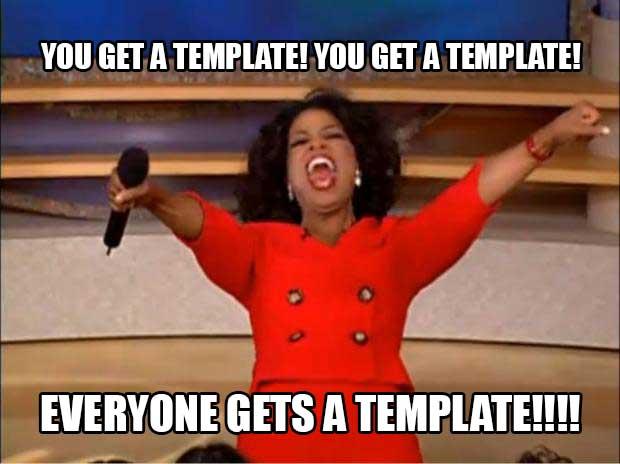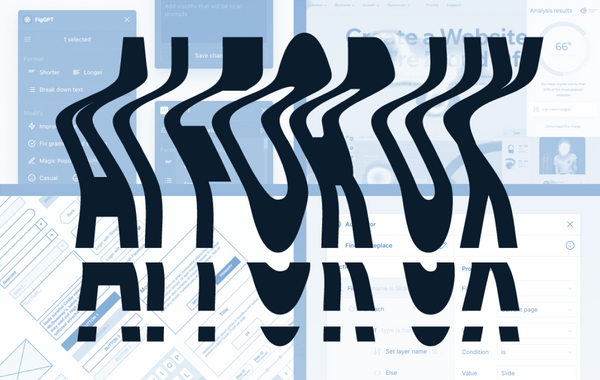Design Templates
By:
Ashley Trommler
on 9/15/2020
As a graphic designer, quite often I’ll have clients ask me to create a “template” to handoff for them to use for various deliverables such as print ads, social posts, etc. While this seems like a simple request, there are complex questions to answer in order to determine if a template is the right fit for a creative piece.

When clients request templates, a big reason is so that they can make changes to the creative internally, saving money and eliminating the back-and-forth requests to an agency. Despite what Oprah says, templates aren’t as simple as they seem and do not work in all cases.
So, what pieces warrant a template?
The best case for creating and using a template is when the layout stays exactly the same and copy and images are the only things switching out. Food menus, business cards, and email blasts are great examples of when a template can come in handy and keep your brand consistent.
Keep in mind that content informs the design and layout. If your main message and concept are changing for a specific piece of creative - think social posts or print ads - a template will not be the most effective approach because it will pigeon hole you to one layout that may not work for every message you are trying to communicate.
Other examples of when a template might not be the best idea is when content will change tremendously such as annual reports, newsletters, and presentations. While there are guidelines that can be set to help create these items, a template used outside of a design team and design software would be very time consuming to create and at the end of the day, may not be worth the investment. But don’t worry - we have solutions for both cases because we’d never leave you high and dry.
Helpful tools
Editable PDFS - These are great for small scale projects that don’t need a whole lot of editing. For example, business card templates can work well in this format where a few key pieces of information will change, but will not affect the overall layout. The beauty of this method is that designers can create custom documents in any of the Adobe Creative Suite programs and save them out as editable PDFs. The designer can then open the file in Adobe Acrobat and assign text fields that the end user can fill in and change. The end user will just have to purchase Adobe Acrobat Pro to edit and the learning curve there is pretty low. Food menus, name badges, and price tags are all other examples of when this technique can come in handy.
Google Slides - VIA has used google slides for templated presentations for ourselves as well as our clients. Where this tool lacks in design capabilities, it makes up for in accessibility and collaboration purposes. It’s best to keep design as simple as possible when setting up templates because the design toolset is very limited compared to professional design software. A designer can take this method a step further by creating custom icons and illustrations in external programs, and saving them in an ‘assets’ folder alongside the actual google slide file. That way, the end user will have a library of custom branded content they can pull into their presentations.
InDesign - InDesign is a part of Adobe Creative Suite and is used widely by designers. It can be a great tool for setting up long form documents. For example, we are currently working on building a custom RFQ (Request For Proposal) document for one of our clients using this program. Why InDesign? InDesign allows you to set paragraph, character, and object styles - leaving no room for guesswork when it comes to creating new pages. You can also assign as many master pages as you’d like, locking certain information in place. This technique only works if the end user has an InDesign license and has a good understanding of how to use the program. This would be the ideal approach for creating items such as annual reports, presentations, and newsletters since it makes changing out large amounts of information easy and consistent.
Canva - There is an abundance of drag-and-drop, template based software options accessible to anyone with a computer and an internet connection. Canva is one that I have not personally used, but have heard about from non-designers. This, and others like it, could be an option if you do not have access to or the budget for hiring an agency or freelancer. There are already preset templates to choose from where you just plug in your own content.
To my knowledge, there is no perfect solution for handing off work to be easily edited by someone who does not have access to or knowledge of using design software. However, The beauty of partnering with an agency is that you have the ability to get custom, unique designs created just for your company that will set you apart and completely align to your brand.
Related Posts
4 AI Resources To Add To Your UX Design Toolbox
By:Morgan Plappert on 7/18/2023
These AI-powered tools can help you streamline your workflow and empower you to take your designs to the next level.
Read More »Component-Based Web Design
By:Morgan Plappert on 8/9/2024
Designers and developers are always looking for ways to make handoff easier, collaboration more seamless and our processes better aligned. Automation, consistency and efficiency, without compromising creativity. It’s a constant battle and often times, a balancing act.
Read More »
